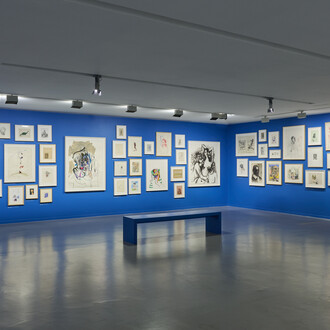For this first retrospective in France devoted to Swiss sculptor Hans Josephsohn (1920–2012), the Musée d'Art Moderne de Paris has entrusted the curatorship to artist Albert Oehlen, who offers a free-wheeling exploration of the artist's work.
Born in 1954, Albert Oehlen is a major artist and contributor to the revival of German painting in the 1980s. An exhibition of his work was held at the Musée d'Art Moderne de Paris in 2009. A great admirer of Hans Josephsohn, Oehlen discovered his work at the Kesselhaus Josephsohn in St Gallen, in Switzerland, where he lives. Both an exhibition and conservation venue dedicated to the sculptor's work, the Kesselhaus which have provided most of the sculptures loaned for this exhibition. Out of his examination of Josephsohn's creative process – interaction with materials, the role of gesture, detail and tireless research – and its resonance with his own explorations, Oehlen draws a spirited experience of the oeuvre.
Hans Josephsohn's work fascinates other artists with the sheer power of its visual language. Peter Fischli and David Weiss were among his early supporters, and in 2007 Ugo Rondinone included several of his reclining nudes in his exhibition The third mind, at the Palais de Tokyo.
The exhibition
The chronological tour takes visitors through three stylistic periods of an artistic output oscillating between figuration and abstraction.
1950s : A simplification of forms
In the late 1940s, Josephsohn's early work was characterised by a paring-down of form and geometrisation. This period was marked by his meeting with Mirjam Abeles, who became his model in 1947 and his wife in 1954. On the postwar, scene abstraction was the dominant avant-garde mode, but Josephsohn adhered to a form of figuration, at a remove from the model, which betrayed convergences with Antiquity – funerary and symbolic Egyptian art in particular - and which recalls in its intensity the works of Alberto Giacometti.
1960-1970: The body embodied
The 1960s marked a turning point in Josephsohn's sculpture, reflected in the figures massiveness. It was also the period when his personal life changed radically: a young model, Ruth Jacob, became his partner. While this relationship found echoes in a more traditional reinvestment in the human body, his figurative work was also pursuing matter down other avenues. During this period he made no secret of his admiration for Aristide Maillol (1861-1944), although his works differed in their treatment of surfaces, the expressiveness of their modelling and a certain hieratic quality. This was a preliminary to the profound transformation that resulted in a third formal upsurge at the dawn of the 1980s.
Fom the 1980s: On the verge of abstraction
Josephsohn developed a sculptural vocabulary that he would never relinquish, digging deeper into the abstraction while retaining a few ever more distant figurative outlines. His gestural speed and virtuosity tended to inject a vibrancy into his material as his heads, busts and reclining nudes changed scale and gained in format. This renewal coincided in 1978 with the arrival in his life of his last partner and model, Verena Wunderlin. The disappearance of the figure opened up a formal field whose artists and historians indicated a proximity to elements and objects that mark our origins: geological aggregates and prehistoric Venuses.
















